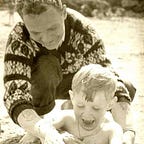BIOPLASTICS
Letting students choose what to study and synthesize
Two articles ago on my medium blog, I wrote about alternative approaches to delivering chemistry topics to high school students.
In my continuing endeavor to inspire students about chemistry, this is my latest attempt.
In our combined class Innovations in Chemistry and Engineering, Zach Swarth and I did a unit on Bioplastics with the students. I learned about this a few months ago at GENSPACE, a community science lab in Brooklyn, where I did a workshop on this with my colleague Tracy Ruditzis.
Here’s what happened in class. I started with a brief intro to the Bioplastics world and why it was important in our world to be rethinking plastics. I put this slide up on the board:
The students picked a Bioplastic to synthesize; after the synthesis was complete, they summarized their experience, documented below.
Here are their stories:
Julia and I (Galena) decided to make the Gelatin-Starch Rubber despite the long list of ingredients. We began by gathering the ingredients, and Julia measured out the 50 g of gelatin first. We had a laugh because we accidentally measured out 0.50 g, thinking we were correct. We realized our mistake, and then I followed and measured 50 g of starch. I then measured out the 80 mL of glycerin. We ran out of class time, so we stored our ingredients for the next class. Julia measured out the 100 ml of water at the beginning of the next class, and then I measured out the 15 ml of vinegar. We began incorporating all of the ingredients, and both thought it was too thick to turn into rubber. We followed Mr. Buckley’s advice and added a splash of vinegar to the mixture. Then we heated it on the hot plate and couldn’t decide how long it would take to be heated to the correct temperature. We couldn’t decide, so we made 3 bars of rubber at one temperature and then heated the mixture for 8 more minutes, and then made 3 more bars of rubber. We had a small issue because the mixture was very clumpy, and so we determined that the bars that were heated longer came out better and did not have any clumps.
Sophia and Susan:
Susan and I made the Gelatin Biolaminate. We chose to make this base as our first try because it was a smaller list of chemicals, so there was less room for error in making the perfect consistency for the plastic. Beginning with putting 2.25g of gelatin in the beaker, we added 1.35 ml of glycerin and combined them. After seeing the consistency and consulting with Mr. Buckley, we decided that adding a few drops more of the glycerin would make it better. We lastly added 135ml of water and placed the mixture on the hotplate. After a few minutes, until the whole mixture was combined, I took the mixture off the heat and poured it straight into the molds. Then I let them sit and dry. They turned out great, and I think we are ready to move on to more advanced recipes.
Ella, Ayevah, Caroline:
We made the Gelatin Biolaminate and the Gelatin Biofoam. The gelatine biolaminate was a lot less successful than the biofoam. We think that the ratio for the biolaminate was off, and that’s why it didn’t set. The biofoam was successful but smelled disgusting; it set well and was two-toned. While making both of the plastics at first, there was no smell, but as soon as we started heating the mixtures, the smell was awful. The gelatin biofoam was hard to mix because of how thick the mixture was, and the magnetic stirrer couldn’t mix it on the hotplate. Because of this, the bottom of it burnt.
The students had a choice on which bioplastic to synthesize; this is an important factor in terms of student engagement, and letting them choose which synthesis they want to do is a win-win situation. The second win is letting the students know that their audience goes beyond the classroom to the public this raises the bar big time; both motivation and feedback are a part of this.
Motivation: When students know that their work will be displayed publicly, they are often more motivated to do their best work. The prospect of having their work seen by others can be a powerful incentive to put in extra effort and produce higher-quality work.
Feedback: Publicly showcasing student work can also provide an opportunity for feedback from a wider audience. This feedback can help students to identify areas where they can improve their work and learn from the perspectives of others.
